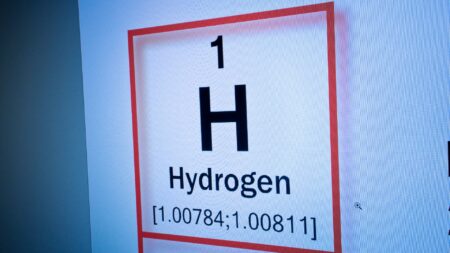While proponents of hydrogen energy assert that it may generate well-paying employment while simultaneously delivering zero-emission electricity, several environmental advocacy groups are concerned about a proposal to establish a hydrogen center in New Mexico.
According to these proponents, using fossil fuels to generate hydrogen could result in additional emissions from natural gas extraction and could divert attention away from the urgent need to switch to renewable energy sources. Around 30 organizations wrote a letter to New Mexico’s governor voicing their concerns.
“New Mexico must prioritize comprehensive, durable, and enforceable climate legislation to light the pathway to a thriving, resilient New Mexico that benefits all of New Mexico’s workers and families,” said Erik Schlenker-Goodrich, executive director of the Western Environmental Law Center, in a statement. “We don’t need a distraction that involves risky bets of taxpayer resources that serves to further entrench the power of fossil fuel corporations.”
The letter begins by outlining natural disasters that are becoming more severe as a result of climate change, including heat waves, wildfires, and flooding.
“These events underscore the imperative for New Mexico to expeditiously move forward with a just and equitable energy transition away from fossil fuels and towards renewable energy — a transition that sets the foundation for a thriving, resilient future for all of the state’s people and communities and its natural heritage,” the letter states.
The groups addressed the letter to Governor Michelle Lujan Grisham, United States Senator Martin Heinrich, United States Senator Ben Ray Luján, United States Representative Teresa Leger Fernández, United States Representative Melanie Stansbury, Land Commissioner Stephanie Garcia Richard, state Senate Majority Leader Peter Wirth, state Senate Pro-tem Mimi Stewart, and state Speaker of the House Brian Egolf.
These concerns arise as hydrogen projects are included in San Juan County’s Energy Transition Act funding bids and as the Escalante Power Plant undergoes conversion to a hydrogen facility.
This letter arrived only days before Friday’s National Hydrogen and Fuel Cell Day. To commemorate the occasion, Secretary of Energy Jennifer Granholm of the United States of America shared a video on social media. She held up a glass of water in the video and stated, “what is in this glass right here can be an enormously powerful tool for us to decarbonize the economy, address the climate catastrophe, and create a ton of high paying employment.”
This was referring to what is known as green hydrogen, a process that utilizes electrolysis to separate hydrogen from oxygen in water. It is more expensive than some other methods of hydrogen energy production, but it enjoys greater backing from environmental groups. Several of the advocacy groups that signed the letter, including the Natural Resources Defense Council, promote green hydrogen. And the letter’s primary issue about green hydrogen was the lack of available water in New Mexico.
However, hydrogen can also be created using fossil fuels. Blue hydrogen is one method of accomplishing this. This is accomplished by splitting the carbon from the hydrogen in natural gas, which is mostly composed of methane.
Granholm stated in the video that blue hydrogen can be carbon neutral if carbon capture and storage technologies are used and methane leaks are corrected in order to minimize detrimental greenhouse gas emissions.
Granholm paid a visit to Farmington earlier this year to learn about hydrogen’s possibilities. Her visit coincided with the drive to enact the Build Back Better legislation, which includes money for hydrogen demonstration projects.
“Those demonstration projects have the potential of creating hydrogen deployments in key areas that are transitioning away from fossil fuels and create good-paying jobs in the process,” Granholm said in the video on Friday.
Noah Long, head of NRDC’s climate and clean energy program in the western region, likened hydrogen energy to a “short path with precipitous precipices on either side.”
“There’s lots of ways that we can do this wrong that will not only increase emissions and risks for our state, but also leave those communities that are hoping that this is a big economic solution hanging if it doesn’t pan out,” he said. “So I think it’s better for everybody to take those risks seriously upfront and to work together with meaningful consultation to the affected communities to see if there are, first of all, opportunities across the entire economy that we can all agree on for decarbonisation, but also to the extent that hydrogen is part of that solution that we’re working together to do it in a way that addresses those risks.”
Long discussed his concerns about hydrogen obtained from fossil sources.
“We do not believe that blue hydrogen or hydrogen derived from fossil methane is a viable long-term option for decarbonisation, and even in the near term, it poses considerable concerns,” he said.
Long stated that New Mexico has high levels of emissions from fossil fuel production in the upstream sector. He expressed hope that new restrictions aimed at reducing methane emissions will help, but noted that “it is still a pretty dirty system.”
After the hydrogen is removed from the carbon, Long stated that the carbon must be utilized. One possibility is to pump it into subsurface storage reservoirs. While New Mexico is investigating options for that type of injection, the state currently does not have any injection wells for that purpose.
However, even if those issues are resolved, Long believes that green hydrogen produced by electrolysis will become more economically viable in the future.
“I believe there are reasons to hope that green hydrogen, or hydrogen produced from renewable sources, will be a component of the long-term solution for decarbonization here in New Mexico,” he added. “However, we must do it correctly, considering the state’s severe and growing water shortages.”
He stated that hydrogen energy is expected to be able to deliver sustainable, clean energy to hard-to-decarbonize regions.
However, Long voiced concern that the focus on hydrogen may divert attention away from other necessary answers to the climate challenge.
“It makes no sense to me that we would advance hydrogen policies, resources, and investments at the expense of the obvious decarbonisation policies and pathways that we know we require,” he said.
Among these policies and initiatives are a more rapid deployment of renewable energy and electric vehicle infrastructure to cut transportation emissions. He added that New Mexicans must also have access to “healthy, comfortable, safe, and energy-efficient houses” that are not dependant on fossil fuels.
Mike Eisenfeld, a Farmington resident and the energy and climate program manager for the San Juan Citizens Alliance, is concerned about this push to construct a hydrogen hub, which has centered on the San Juan Basin’s natural gas supplies. The basin is located beneath a methane hotspot created, in part, by emissions associated with fossil fuel extraction. Additionally, it is a region that is attempting to diversify its economy in advance of coal-fired power plant closures.
“We were assured that this region has the potential to become a centre for renewable energy and storage,” Eisenfeld told NM Political Report. “That was part of the discussion surrounding the Energy Transition Act and what we continue to believe is the best compatible solution to the situation we’re in.”
The New Mexico Legislature approved the Energy Transition Act in reaction to news that the coal-fired San Juan Generating Station would close in 2022.
Eisenfeld stated that the priority should be on renewable energy development, as it will take at least a few years to thoroughly examine and implement hydrogen projects.
If New Mexico chooses to explore hydrogen, the advocacy groups gave a checklist of considerations.
While the groups support green hydrogen, they argue that the arid climate of New Mexico and the ongoing drought should be recognized. Additionally, they raised concerns about the effects of fossil fuel extraction on cultural places, human health, and the environment.
Additionally, the groups raised concern about the transportation and storage of hydrogen, which is corrosive and could cause harm to natural gas pipelines that are not equipped to handle high concentrations of hydrogen.
“I’ve worked to try to prevent and minimize the impacts of natural gas development for over three decades,” said Gwen Lachalt, a San Juan County resident and the executive director of Western Leaders Network, when reached by NM Political Report. “And I’m just really concerned about adding blue hydrogen, or fossil hydrogen, to our energy mix when, even though New Mexico is making great strides with strong methane rules, we still have a huge methane problem. We still live under a methane cloud in the Four Corners from the oil field and we’ve worked for so long to debunk the myth that natural gas is clean energy and it just simply isn’t. Cradle to grave impacts of natural gas development are huge. And, as we know now, it’s a major contributor to greenhouse gases and [methane] is a much more potent greenhouse gas.”








